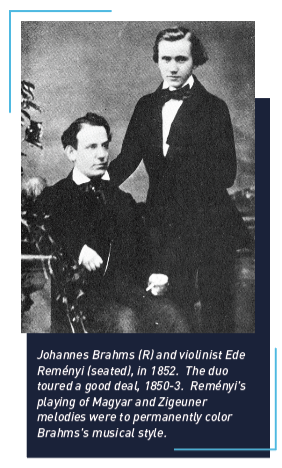 Composed 1861; 41 minutes
Composed 1861; 41 minutes
With its exuberant Roma-style finale, sweeping first movement, introspective Intermezzo, and expansive slow movement, Brahms called his G minor Piano Quartet the easiest of his chamber works to “hear at sight.” It was this work he chose to introduce himself—as both composer and pianist—to the Viennese public on November 16, 1862. The opening movement is dark, powerful, and packed with invention. From the outset, Brahms shows how rich in potential his themes can be. The piano’s somber opening octaves are echoed, inverted, and passed between instruments, revealing the thematic interconnectivity that defines the entire piece. Brahms draws vast architectural arcs from a wealth of ideas, surging from lean textures to symphonic grandeur, darkness to light, austerity to radiance.
The Intermezzo offers a delicate counterweight to the stormy first movement. Brahms had first titled this understated, muted movement ‘Scherzo’, but its hushed tones, dark murmurings, and veiled introspection suggested otherwise. He told Clara Schumann (who had given the première one year earlier to the day in Hamburg) that he thought of her in every bar. She, in turn, wrote: “It is a piece after my own heart...I can dream so gently. It is as if my soul were rocked to sleep on its sounds.”
The finale lets loose. Ever since its première, this Roma-style rondo has been an audience favorite. Following a tradition dating back to Haydn, Brahms develops boisterous, Magyar-flavored three-bar phrases, pairing them with more tender episodes in thirds. The great Hungarian violinist Joseph Joachim—then riding high on his own Concerto in Hungarian Style—saluted Brahms’s instinct for the idiom: “You have outstripped me on my own turf by a considerable track,” he wrote.